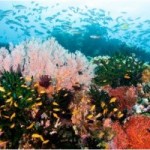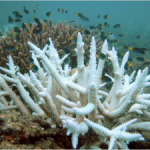June 4, 2012
Summer Blog Series – Kirstin Silvera Blogs from Costa Rica: Climate Change and our Coral Reefs
As part of our summer-long blog series, Kirstin Silvera, a member of the CC-RAI team will be discussing climate change and its impact on coral reefs, biodiversity and more from a research placement in Costa Rica. Kirstin is currently a graduate student in the Faculty of Environmental Studies at York University and will begin her Law degree this coming fall. In the first of the series, Kirstin outlines the impact of climate change on coral reefs around the world.
 While some marine organisms can afford to change habitats in response to changing climates, coral reefs do not have that option. Therefore it is important to understand the effects that climate change can have on our ocean’s coral reefs and species.
While some marine organisms can afford to change habitats in response to changing climates, coral reefs do not have that option. Therefore it is important to understand the effects that climate change can have on our ocean’s coral reefs and species.
Coral reefs are one of the most biodiverse habitats on earth, and the most biodiverse of all marine ecosystems, containing approximately 25 percent of all fish species (IPCC, 2007). However, as the oceans warm while the earth’s temperature increases, corals are at a higher risk of mortality.
Corals are harmed with climate change because of ocean temperature increases and because of increased ocean acidification (U.S. EPA, 2011). Coral reefs are sensitive to changes as small as a one degree Celsius rise in ocean temperature, and if sustained for a period as small as six weeks extensive coral bleaching can occur (Australian Government, n.d.). In these situations if temperatures do not return to normal, widespread coral mortality can result (Australian Government, n.d.).
As temperatures in the oceans rise, algae, which have a symbiotic relationship with corals, are lost (Nicholls et al., 2007). This causes the corals to stress and bleach, and as previously mentioned if increased temperatures are sustained, coral mortality will occur. In addition, ocean acidification increases as a result of increased carbon dioxide emissions (U.S. EPA, 2011b). As ocean acidification increases, the availability of calcium carbonate declines, which results in a decrease in calcification for corals (Fischlin et al., 2007). It is important to note that climate change is not the direct contributor to ocean acidification, but rather is a result of increased CO2 which also causes climate change (U.S. EPA, 2011b).
The world’s corals provide refuge and habitat for many marine species (Fischlin et al., 2007). For the world’s biggest reef, the Great Barrier Reef, the Australian Government (n.d.) has identified climate change as the reef’s greatest long-term threat. On top of losing precious biodiversity, an Oxford Economics report estimates the economic losses that could be suffered to Australia’s economy would be around $37.7 billion (ABC News, 2009).
The Mesoamerican Barrier Reef, the world’s second largest reef, has been suffering as a result of climate change as well. Currently, the reef, which is not only biologically but economically vital for the region, is suffering from coral bleaching as a result of warming ocean temperatures. The loss of the reefs which provide habitat for a variety of species has resulted in losses for fisheries, which depend on species that need the reef for their survival.
 When bleaching occurs the coral loses its colour and its ability to function. While some corals may return to their natural state after bleaching if environmental conditions return to normal, fecundity and growth rates may still be negatively impacted (Nicholls et al., 2007). Below is an example of what coral bleaching looks like.
When bleaching occurs the coral loses its colour and its ability to function. While some corals may return to their natural state after bleaching if environmental conditions return to normal, fecundity and growth rates may still be negatively impacted (Nicholls et al., 2007). Below is an example of what coral bleaching looks like.
When thinking about the state of the world’s coral reefs, it is important to remember that “coral reefs are among the most vulnerable of all ecosystems to climate change” (Australian Government, n.d.). Overall, the state of the largest coral reefs in the world depends on mitigating stressors from multiple sources which threaten their survival. However, if we are to address any of these factors, climate change should be very high on the priority list.
If you are interested in any the references listed above or would like additional information check out the reference guide Kirstin prepared. Also take a look at Kirstin’s other blogs from Costa Rica.




Comments are closed here.